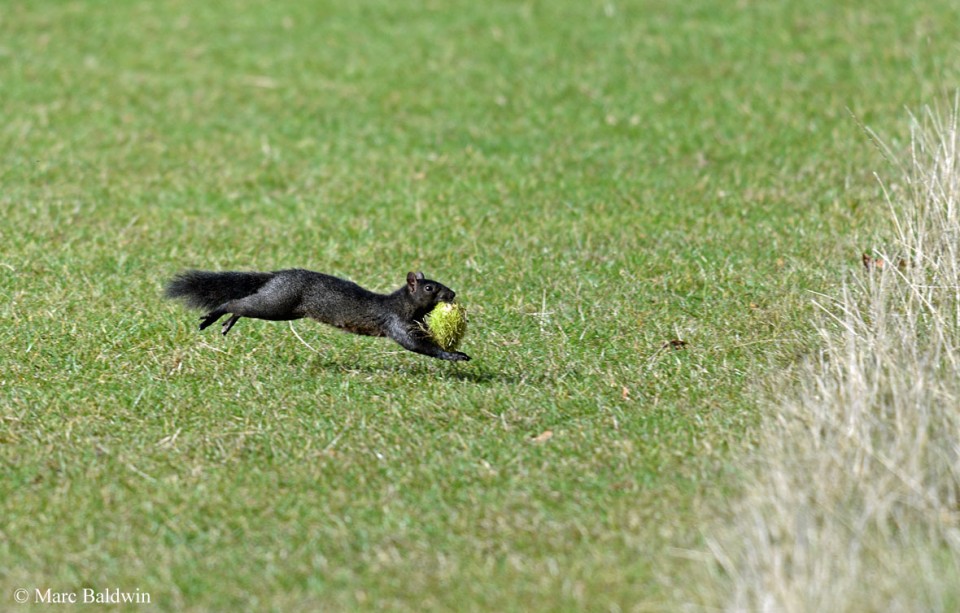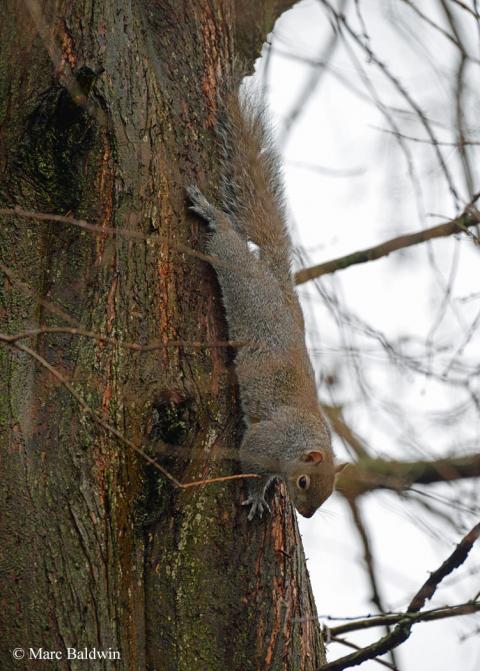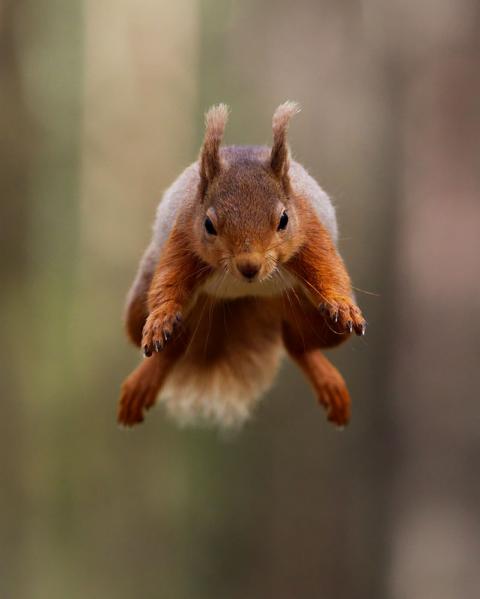Squirrel Behaviour - Locomotion

Grey squirrels are less arboreal (i.e. spend less time in the trees) than their Red counterparts, but both species generally move in much the same way. Movement on the ground is perhaps best described as a "leaping" gait and in their Handbook of British Mammals, Corbett and Harris describe the terra firma locomotion as: "a weaving run or a series of leaps with the tail held out behind". While on the ground squirrels are highly alert and will frequently sit upright, with their ears erect, surveying for danger.

I've found very little in the literature regarding the "top speed" of squirrels. My experience suggests they can run at several metres per second and Alex Reisner, on his Speed of Animals website, gives the top speed for Greys as 12.4 mph (20 kph), although he doesn't cite a source. A friend of mine recently caught the blur of a Grey running across her garden on a trailcam setup to monitor fox activity. Based on the measurements she provided of her garden and an approximate timing using a stopwatch, I estimated the squirrel to be moving at about five metres (16 ft.) per second, or 11 mph (18 kph). Eleven miles per hour doesn't sound particularly fast, but we need to factor in the squirrel's size. When we consider that this distance equated to 16-times the squirrels body length, it's the equivalent of me driving our four-metre-long (13 ft.) Ford Fiesta at about 160 mph (257 kph). This particular squirrel may not have been going full throttle, but at the time I suspected it wasn't far off. Subsequently, slowing down and timing the escape of a Red squirrel from one of Craig Shuttleworth's traps during February 2024, along with a cable-camera videography setup used by Terry Abraham while filming Reds in Cumbria during 2022, suggests a top speed of about 20 mph (32 kph).
In the trees, squirrels are impressively agile, Reds noticeably more so than Greys in my experience, leaping acrobatically between branches several metres off the ground, running around and up and down tree trunks head first. Indeed, squirrels use the claw on the longest digit on each foot to anchor them to the bark, while the unique flexibility in the joint between the talus (ankle bone) and calcaneus (heel bone) allows them to turn their feet outwards 180 degrees without moving the rest of the leg. This adaptation allows them to place their feet flat against the trunk and means they can move up and down a trunk head first. The paws have ten pads; the two at the base, by the wrist, are much larger than those at the "fingers" and contain more fatty tissue, which allows them to act as shock absorbers when the squirrel lands.

While running the tail is used as a counterbalance to help the squirrel steer and turn quickly. Many short vertebrae at the base of the tail allow the tail considerable flexibility in almost every plane. While jumping, the tail is held horizontally behind the squirrel and, although it does not act as a parachute, it helps improve the squirrels aerodynamics because the increased body length helps reduce the squirrel's drag coefficient (the lateral hairs on the tail are longer than those on the top and bottom, resulting in a feather-like shape that reduces wind resistance). Squirrels will often pump their tails at 'take off' and while in "flight', which may help accelerate the squirrel through the air. Grey and Red squirrels are accomplished jumpers and seem to have little difficulty moving between branches in the canopy.
There have been very few attempts to measure the maximum jumping distance, but in the The Eurasian Red Squirrel, Stefan Bosch writes that he has observed Reds jumping 2m (6.5 ft.) gaps and I have seen similar distances cleared by Reds on the Isle of Wight. Richard Thornington was more methodical in his approach with Greys and moved two feeding platforms further and further apart to assess how far his subjects could jump -- he found they could clear a 2.5m (8.2 ft.) gap, so about ten-times their body length.
Despite being impressively agile in the tree tops, squirrels do occasionally lose balance and fall while chasing one another. I have seen a squirrel fall approximately 3m (10 ft.) from a tree onto a concrete drive with a 'smack' that made me wince; it stood up, noticed me and then ran up the nearest available trunk, seemingly none the worse for wear. I wasn't able to follow this squirrel, so I cannot say whether it had sustained injuries in the fall, but there was no blood and the squirrel was not obviously limping or moribund. Fortunately for falling squirrels, small animals have the benefit of a large surface area to volume ratio, which means that upon abrupt collision with a hard surface, their volume has proportionally more surface area in which to expand; this means they are less susceptible to the damage that a large animal would suffer falling from the same height.
Both species are able to swim ("doggy paddle") well and are surprisingly quick in the water.
